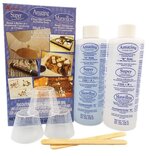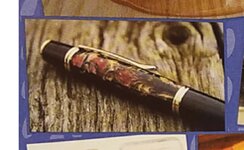On side of bottle of my "Alumilite Clear" bottles that I got from Hobby Lobby:
Mix Ratio: 1 to 1 by Volume
Work Time: 30-40 minutes
Demold Time: 24-48 hours
This says nothing about "by weight" anywhere in the paperwork that came with it or on the bottles. I'll just assume that the formulation you are using is totally different, and has different instructions.
I will say that the alumilite blanks that I've made using this stuff, after baking, have come out quite nicely, without interior bubbles and voids that I've heard so many bad things about. It could just be that I'm using the heat properly, to encourage the bubbles to leave the mix before setting (It DOES happen to have a 30 - 40 minute working time), or it could just be luck.
This stuff that I'm working with (the Alumilite Clear, from Hobby Lobby - 16 oz package in 2 8-oz bottles), I get it up to around 110 - 120 degrees by sitting it on top of this radiant heater before I measure and mix. The "Part B" flows quickly, more like a light syrup. The "Part A" flows more slowly, like a heavy syrup.
I mix the 2 parts together, then I add the mixed resin to the aggregate materials (crushed abalone shells) and powdered pigments (crushed/shaved colored chalks). I mix again, introducing a ton of air bubbles in the process ... then I level out the materials in the bottom of the mold and set them back on the heater. 20 minutes later, bubbles are all at the top of the molding, and the resin beneath the bubbles looks very clear.
In another 10 hours, or so, this latest batch that I poured about 2 hours ago will be unmolded and baked for 30 minutes at 200 degrees. I think my friend will be quite happy with the "Pink'n'Pearl" mix.



